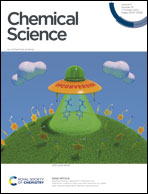Lewis acid-assisted Ir(iii) reductive elimination enables construction of seven-membered-ring sulfoxides†
Abstract
Iridium has played an important role in the evolution of C–H activation chemistry over the last half century owing to its high reactivity towards stoichiometric C–H bond cleavage; however, the use of Ir(III) complexes in catalytic C–H functionalization/C–C bond formation appears to have fallen off significantly. The main problem lies in the reductive elimination step, as iridium has a tendency to form stable and catalytically inactive Ir(III) species. Herein, with a rationally designed Lewis acid assisted oxidatively induced strategy, the sluggish Ir(III) reductive elimination is successfully facilitated, enabling the facile C–C bond formation. The X-ray crystal structure of a silver salt adduct of iridacycle and DFT calculations demonstrate that the sulfoxide group acts as a key bridge connecting the Ir(III) metal centre with the silver Lewis acid, which facilitates the reductive elimination of the Ir(III) metallacycle. Further identification of oxidants was carried out by performing stoichiometric reactions, which enables the development of catalytic construction of various highly functionalized seven-membered-ring sulfoxides, that are of great interest in medicinal chemistry and materials science.



 Please wait while we load your content...
Please wait while we load your content...